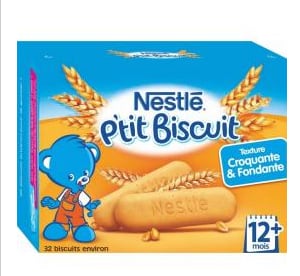The survey was carried out by three non-profit organisations - SumOfUs, Changing Markets and WECF Network - which aim to promote corporate accountability and sustainability.
Nestle’s P'tit Biscuit for toddlers age 12 mois) had the highest level of all the samples with 226.1 micrograms per kilogram (µg/kg) of acrylamide, putting them above the EU benchmark level for biscuits and rusks for babies and young children of 200 µg/kg.
Similar products by German manufacturer Hipp Biologique and private label biscuits by French retailer Auchan had around seven times less than this at under 30 µg/kg.
A spokesperson for Nestlé told FoodNavigator: "Regular monitoring by independent external laboratories shows that acrylamide levels in our baby biscuits are significantly lower than EU guidance levels. That is why we are very surprised by the results published in the SumOfUs Report. We are looking into the report and we welcome a dialogue with SumOfUs to better understand the analytical testing methods they used and the resulting data they gathered, as well as share our own initiatives and data we have for our products."

Two samples of biscuits and rusks from the Picot and Carrefour brands were found to have concentrations very close to the benchmark (198,3 and 192 µg/kg respectively).
The NGOs tested seven products by Hipp Biologique and all had less than 30 µg/kg apart from one sample (apple flavoured 'growing' biscuits for toddlers over one year) which contained 96.3 µg/kg.
President of WECF France Véronique Moreira said: “It is unacceptable that even major brands do not seem to be taking full responsibility to reduce acrylamide levels in their products ignoring the long-term health impacts these could have on most vulnerable consumers such as babies and young children.
"These findings highlight the urgency to put in place a robust EU regulatory framework so that food operators make real efforts in lowering acrylamide levels across their products.”
The samples, taken from different supermarkets in Nantes, France last month, were analysed for acrylamide by accredited British laboratory Fera Science using gas chromatography−mass spectrometry.
Acrylamide occurs naturally in certain foods and can increase during frying and roasting. It cannot be entirely eliminated from food but there are a number of measures that can reduce it at farm and factory level.
Farmers can select potato varieties low in reducing sugars, ensure they are mature before harvesting and keep storage time to a minimum.
Food manufacturers can use asparagine reducing agents.
Coffee manufacturers can opt for darker and longer roasting periods.
Manufacturers making products made from cereals should optimise thermal and moisture inputs and reduce browning of the final product.
Potato slices should be washed, blanched or peeled and the darkest potatoes should be removed.
Source: FoodDrinkEurope and Serving Europe
Acrylamide, a chemical contaminant that is known to increase the risk of cancer, forms naturally when starchy foods are fried or roasted and occurs both in home cooking and during industrial food processing.
Fried potatoes, coffee and coffee substitutes and cereal-based foods such as biscuits are the biggest contributors to Europeans’ intake, and a 2012 scientific opinion by the European Food Safety Authority (EFSA) – confirmed in 2015 – said exposure was as a concern across all age groups.
Infants, however, are the most exposed to the contaminant per kilo body weight.
The Commission has set a range of indicative values for acrylamide levels in different food groups which are not legally binding, but are intended to be used as benchmark levels to assess the extent to which the codes of practice has been applied by food manufacturers.
Last month the director of the EU’s Food and Feed Safety and Innovation Unit, Sabine Juelicher, announced plans to set maximum levels for acrylamide in ready-to-eat foods such as baby foods, crisps and breakfast cereals, although details of the actual levels and the full list of affected foods have yet to be decided.
The Nestlé spokesperson said it supported the existing mandatory codes of practice approach. "The codes of practice as implemented by Nestlé have reduced levels of acrylamide even below the maximum limits being considered by the EU. We would respect and comply with any regulatory measures brought in to manage this issue."
The Commission has been under pressure to tighten rules from public health campaign groups and authorities in member states. In January last year, Denmark lowered its indicative levels for acrylamide, arguing that EU guidance levels did not protect consumers enough.
Recently foods were recalled from shelves in Croatia, Hungary, Slovakia, Slovenia and Bulgaria for having high levels of the carcinogen.
